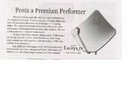Channel Hopper said:
The dish size and reflector design difference is relevant however. From memory the Penta was designed with improved sidelobe performance and strength over the standard oval shaped reflectors and what you dislike most was the result of this research.
Oooh lookee !
www.ndsatcom.com/en/products/shop.php?catID=136&artID=63
www.holkirk.com/Quick-Deploy-Ka-Band-Flyaway-Antennas--TP2-120.htm
I buy the strength argument, as these are both fly-away systems that requires extra rigidity with as little thickness as possible, making them better for flat-pack than an SMC dish (that has the ribs in the back providing rigidity).
(Wouldn't this make them the ideal IKEA dish? Now there's a prediction for you...)
I suspect the prodelin/CM/Visiosat still use the almost oval shape for the fixed and non-gregorian installations as this still give better signal compared to the amount of surface area you have in the wind.
Or maybe there's a niche market there... dishes in any shape you want (as long as it as an illuminable inner oval). Apple-dishes that cost 15% more than others, bat-dishes, you name it.
(and erhm... aren't we supposed to not post external live links on the site?)

